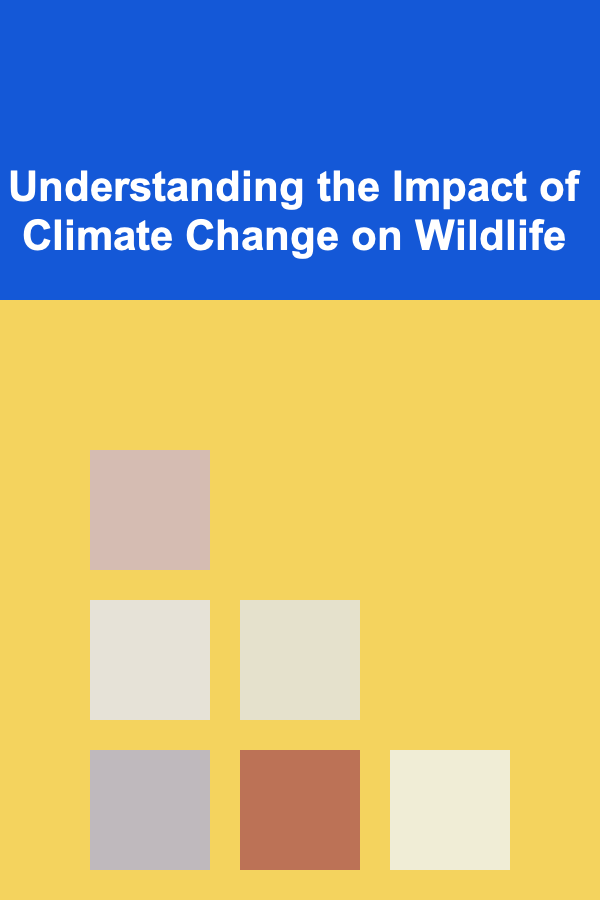
Understanding the Impact of Climate Change on Wildlife
ebook include PDF & Audio bundle (Micro Guide)
$12.99$6.99
Limited Time Offer! Order within the next:

Climate change, driven primarily by human activities, is no longer a distant threat; it's a present-day reality reshaping ecosystems and profoundly affecting wildlife populations across the globe. Understanding the complex interplay between a changing climate and the survival of various species is crucial for effective conservation efforts. This article delves into the multifaceted impacts of climate change on wildlife, exploring the underlying mechanisms, observing the observable effects, and discussing the strategies needed to mitigate the risks and foster resilience.
The Mechanisms of Impact: How Climate Change Alters Wildlife Habitats
Climate change manifests in several key ways, each contributing uniquely to the disruption of wildlife habitats and the challenges faced by animals:
- Rising Temperatures: The most direct and widely recognized impact is the increase in average global temperatures. This warming trend extends to both terrestrial and aquatic environments, exceeding tolerable thresholds for many species. For example, rising ocean temperatures contribute to coral bleaching, devastating reef ecosystems and impacting the countless species that depend on them for food and shelter. On land, warmer temperatures can lead to heat stress, altered metabolic rates, and changes in species distribution as animals seek cooler refugia.
- Changes in Precipitation Patterns: Climate change is not just about warming; it's about altered weather patterns. Some regions are experiencing more intense and frequent droughts, while others are facing increased flooding. These shifts in precipitation dramatically alter water availability, impacting plant life (the foundation of many food webs) and directly affecting animals that rely on specific water sources. Droughts can lead to widespread habitat loss, increased competition for dwindling resources, and heightened risk of wildfires. Conversely, increased flooding can inundate nesting sites, displace animals, and spread diseases.
- Sea Level Rise: Melting glaciers and thermal expansion of seawater are causing sea levels to rise, threatening coastal habitats crucial for many species. Coastal wetlands, mangrove forests, and low-lying islands are particularly vulnerable, providing essential breeding grounds and foraging areas for birds, marine mammals, and other wildlife. As these habitats are submerged, animals are forced to relocate or face extinction. Sea level rise also increases the frequency and intensity of coastal flooding, further disrupting ecosystems and threatening human communities.
- Ocean Acidification: The ocean absorbs a significant portion of the carbon dioxide released into the atmosphere. This absorption leads to a decrease in the pH of seawater, a process known as ocean acidification. Acidification makes it harder for marine organisms, such as shellfish, corals, and plankton, to build and maintain their shells and skeletons, disrupting the entire marine food web. This effect has cascading consequences, impacting larger marine animals that depend on these smaller organisms for food.
- Increased Frequency and Intensity of Extreme Weather Events: Climate change is exacerbating extreme weather events like hurricanes, cyclones, heatwaves, and wildfires. These events can cause massive habitat destruction, direct mortality of wildlife, and long-term ecological damage. Animals that are already stressed by other climate change impacts are particularly vulnerable to these extreme events. For instance, a severe heatwave can push a struggling population over the edge, leading to localized extinctions.
Observable Effects: Documenting the Changes in Wildlife Populations
The impacts of climate change on wildlife are not theoretical; they are observable and increasingly well-documented. Scientists are gathering evidence from around the world, revealing the diverse ways in which animals are responding to a changing climate:
- Range Shifts: Many species are shifting their geographic ranges in response to changing temperatures and precipitation patterns. Animals are moving towards cooler, higher-latitude or higher-altitude regions in an attempt to stay within their optimal climatic zones. This can lead to changes in species composition within ecosystems, as new species arrive and others disappear. However, range shifts are not always possible, especially for species that are isolated or have limited dispersal abilities. Furthermore, even successful range shifts can create new challenges, such as increased competition with resident species or encountering unfamiliar predators and diseases.
- Phenological Shifts: Phenology refers to the timing of biological events, such as breeding, migration, and hibernation. Climate change is disrupting these established patterns, causing some species to shift the timing of their life cycle events. For example, some birds are migrating earlier in the spring, while some plants are flowering earlier. These shifts can create mismatches between species that depend on each other, such as migratory birds that arrive at their breeding grounds to find that their insect prey has already emerged. These phenological mismatches can have devastating consequences for populations.
- Changes in Body Size and Morphology: Some studies suggest that climate change is causing changes in the body size and morphology of certain species. For example, some animals are becoming smaller, potentially as a way to cope with warmer temperatures and reduced resource availability. Other animals may be changing their coloration or fur thickness in response to altered environmental conditions. These changes can affect an animal's ability to compete, reproduce, and survive.
- Increased Disease Outbreaks: Climate change can alter the distribution and prevalence of diseases, impacting wildlife populations. Warmer temperatures can expand the geographic range of disease vectors, such as mosquitoes and ticks, exposing animals to new diseases. Climate change can also weaken the immune systems of animals, making them more susceptible to disease. The spread of diseases can have devastating consequences, particularly for already vulnerable populations.
- Population Declines and Extinctions: The ultimate consequence of climate change impacts on wildlife is population decline and, in the worst cases, extinction. Many species are already experiencing significant population declines due to climate change, and some have already gone extinct. Species that are particularly vulnerable include those that are specialized to specific habitats, those that have limited dispersal abilities, and those that are already facing other threats, such as habitat loss and pollution. The loss of even a single species can have cascading effects on the entire ecosystem.
Specific Examples: Climate Change Impacts on Different Wildlife Groups
To illustrate the broad impact of climate change, consider these specific examples across different wildlife groups:
- Polar Bears: Polar bears rely on sea ice for hunting seals, their primary food source. As sea ice melts due to rising temperatures, polar bears are losing their hunting grounds, leading to starvation and population declines. They are forced to swim longer distances to find ice, expending valuable energy and increasing their risk of drowning. The future of polar bears is inextricably linked to the fate of Arctic sea ice.
- Coral Reefs: Coral reefs are among the most biodiverse ecosystems on Earth. However, they are highly sensitive to changes in ocean temperature. Even small increases in temperature can cause coral bleaching, a phenomenon where corals expel their symbiotic algae, leading to starvation and death. Ocean acidification further exacerbates the problem, making it harder for corals to rebuild their skeletons. The loss of coral reefs has devastating consequences for the countless species that depend on them.
- Amphibians: Amphibians are particularly vulnerable to climate change because they have permeable skin and rely on water for reproduction. Changes in precipitation patterns, such as increased droughts, can dry out their breeding ponds, leading to reproductive failure. Climate change can also increase the prevalence of diseases, such as chytrid fungus, which is decimating amphibian populations worldwide.
- Migratory Birds: Migratory birds are facing multiple challenges due to climate change. Changes in temperature and precipitation patterns can disrupt their migration routes and breeding cycles. They may arrive at their breeding grounds to find that their food sources are no longer available. Extreme weather events, such as hurricanes and droughts, can also impact migratory bird populations.
- Mountain Gorillas: Mountain gorillas live in high-altitude forests, which are experiencing changes in temperature and precipitation patterns due to climate change. These changes can affect the availability of their food sources and increase the risk of disease. Furthermore, climate change can indirectly impact mountain gorillas by increasing human pressure on their habitats, as people seek new resources in response to changing environmental conditions.
Understanding Vulnerability: Why Some Species are More at Risk
Not all species are equally vulnerable to the impacts of climate change. Several factors determine a species' vulnerability:
- Specialized Habitat Requirements: Species that rely on specific, limited habitats, such as those dependent on specific types of forests or particular water temperatures, are more vulnerable. Any alteration to that specific habitat drastically impacts the species' survival.
- Limited Dispersal Ability: Species that cannot easily move to new locations are at higher risk. This includes species with physical limitations, fragmented habitats that impede movement, or territorial behavior that prevents migration.
- Low Genetic Diversity: Populations with low genetic diversity are less adaptable to environmental changes. They lack the variation needed to evolve and survive under new conditions.
- Slow Reproductive Rate: Species with slow reproductive rates and long generation times are less able to recover from population declines caused by climate change. They simply cannot reproduce quickly enough to offset losses.
- Existing Stressors: Species already facing other threats, such as habitat loss, pollution, or overexploitation, are more vulnerable to the added stress of climate change. The cumulative effect of these stressors can be devastating.
- Trophic Level: Species at higher trophic levels (top predators) are often more vulnerable because they depend on a stable and healthy food web. Disruptions at lower trophic levels can have cascading effects on top predators.
Mitigating the Impacts: Conservation Strategies and Actions
While the challenges posed by climate change are significant, there are actions we can take to mitigate the impacts on wildlife and foster resilience:
- Reducing Greenhouse Gas Emissions: The most important step is to reduce greenhouse gas emissions, the primary driver of climate change. This requires a global effort to transition to renewable energy sources, improve energy efficiency, and reduce deforestation. Individual actions, such as reducing our carbon footprint and supporting policies that promote climate action, can also make a difference.
- Protecting and Restoring Habitats: Protecting and restoring natural habitats can help wildlife adapt to climate change. This includes conserving existing forests, wetlands, and other ecosystems, as well as restoring degraded habitats. Healthy ecosystems are more resilient to climate change and provide essential resources for wildlife. Habitat connectivity is also crucial, allowing animals to move to new areas as their ranges shift.
- Managing Protected Areas: Protected areas, such as national parks and wildlife refuges, play a critical role in conserving biodiversity. However, climate change is challenging the effectiveness of protected areas, as species move outside of their boundaries. It is important to adapt management strategies to account for climate change, such as expanding protected areas, creating corridors between protected areas, and actively managing habitats to improve their resilience.
- Reducing Other Stressors: Reducing other stressors on wildlife, such as habitat loss, pollution, and overexploitation, can help them cope with the added stress of climate change. This includes implementing sustainable fishing practices, reducing pollution levels, and combating illegal wildlife trade. Addressing these other stressors can give wildlife a better chance of surviving in a changing climate.
- Assisted Migration (Translocation): In some cases, it may be necessary to actively move species to new locations where they are more likely to survive. This strategy, known as assisted migration or translocation, is controversial because it can have unintended consequences. However, it may be the only option for some species that are unable to adapt to climate change on their own. Assisted migration should be carefully considered and implemented with thorough planning and monitoring.
- Genetic Management and Conservation Breeding: Maintaining and enhancing genetic diversity within wildlife populations is crucial for adaptation. Conservation breeding programs can help bolster populations and preserve genetic variation, while careful management of wild populations can promote gene flow and reduce inbreeding.
- Monitoring and Research: Continued monitoring and research are essential for understanding the impacts of climate change on wildlife and for developing effective conservation strategies. This includes tracking species distributions, monitoring population trends, and studying the effects of climate change on ecosystems. Research can also help us identify the most vulnerable species and develop targeted conservation interventions.
- Community Engagement and Education: Engaging local communities in conservation efforts is crucial for success. Local communities often have valuable knowledge about wildlife and their habitats. Education programs can raise awareness about the impacts of climate change on wildlife and inspire people to take action. Empowering local communities to participate in conservation can lead to more effective and sustainable outcomes.
The Urgency of Action: A Call for Global Cooperation
The impacts of climate change on wildlife are already being felt around the world. The time for action is now. We must act quickly and decisively to reduce greenhouse gas emissions, protect and restore habitats, and implement effective conservation strategies. This requires a global effort, with governments, organizations, and individuals working together to address this critical challenge. The future of wildlife, and indeed the health of the planet, depends on it. Delaying action will only lead to more severe consequences and make it more difficult to reverse the damage. We must embrace sustainable practices, promote biodiversity conservation, and prioritize the well-being of wildlife in a changing climate. This is not just an environmental imperative; it is a moral one. We have a responsibility to protect the incredible diversity of life on Earth for future generations.

How to Prevent Pet Hair from Spreading in Your Home
Read More
How to Sell Your Antique Books Through an Online Marketplace
Read More
How to Soundproof a Home Office for Maximum Productivity
Read More
How to Use LinkedIn Events to Promote B2B Dropshipping Webinars and Networking Opportunities
Read More
How to Understand Black Holes
Read More
10 Tips for Exploring Tide Pools Responsibly
Read MoreOther Products

How to Prevent Pet Hair from Spreading in Your Home
Read More
How to Sell Your Antique Books Through an Online Marketplace
Read More
How to Soundproof a Home Office for Maximum Productivity
Read More
How to Use LinkedIn Events to Promote B2B Dropshipping Webinars and Networking Opportunities
Read More
How to Understand Black Holes
Read More